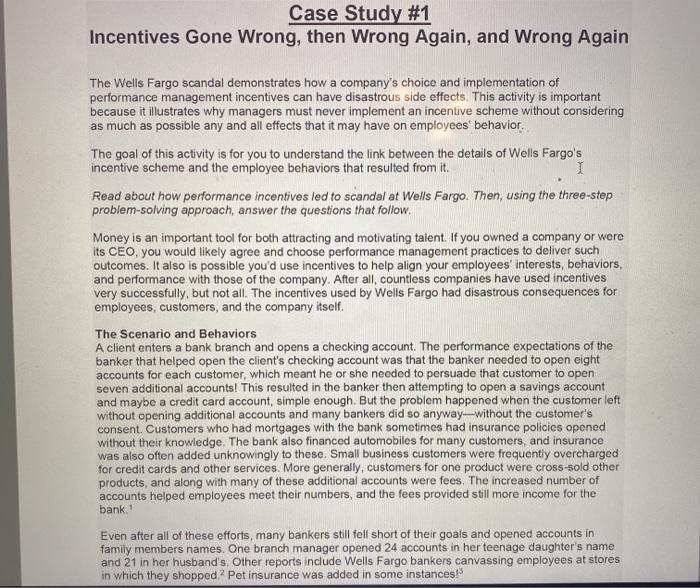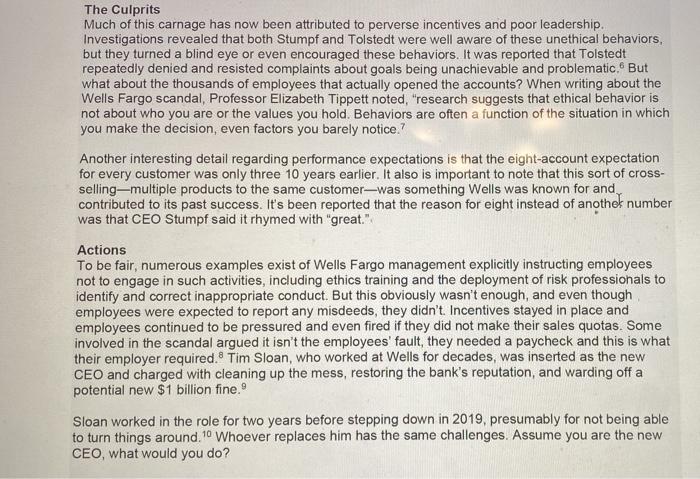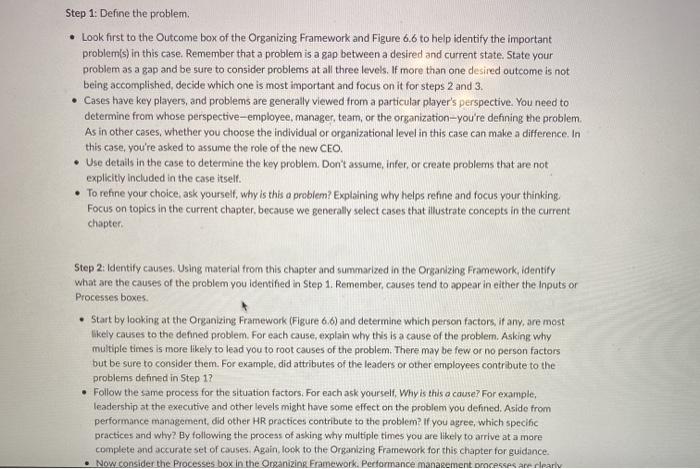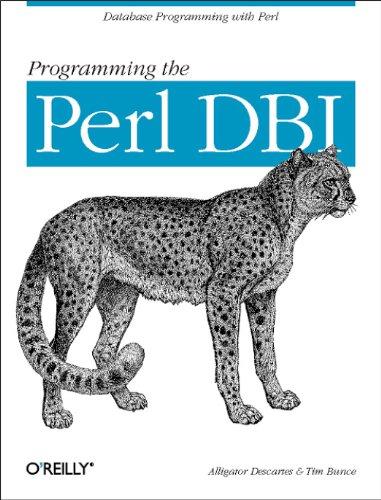Case Study #1 Incentives Gone Wrong, then Wrong Again, and Wrong Again The Wells Fargo scandal demonstrates how a company's choice and implementation of performance management incentives can have disastrous side effects. This activity is important because it illustrates why managers must never implement an incentive scheme without considering as much as possible any and all effects that it may have on employees' behavior. The goal of this activity is for you to understand the link between the details of Wells Fargo's incentive scheme and the employee behaviors that resulted from it. I Read about how performance incentives led to scandal at Wells Fargo. Then, using the three-step problem-solving approach, answer the questions that follow. Money is an important tool for both attracting and motivating talent. If you owned a company or were its CEO, you would likely agree and choose performance management practices to deliver such outcomes. It also is possible you'd use incentives to help align your employees' interests, behaviors, and performance with those of the company. After all, countless companies have used incentives very successfully, but not all. The incentives used by Wells Fargo had disastrous consequences for employees, customers, and the company itself. The Scenario and Behaviors A client enters a bank branch and opens a checking account. The performance expectations of the banker that helped open the client's checking account was that the banker needed to open eight accounts for each customer, which meant he or she needed to persuade that customer to open seven additional accounts! This resulted in the banker then attempting to open a savings account and maybe a credit card account, simple enough. But the problem happened when the customer left without opening additional accounts and many bankers did so anyway--without the customer's consent. Customers who had mortgages with the bank sometimes had insurance policies opened without their knowledge. The bank also financed automobiles for many customers, and insurance was also often added unknowingly to these. Small business customers were frequently overcharged for credit cards and other services. More generally, customers for one product were cross-sold other products, and along with many of these additional accounts were fees. The increased number of accounts helped employees meet their numbers, and the fees provided still more income for the bank Even after all of these efforts, many bankers still fell short of their goals and opened accounts in family members names. One branch manager opened 24 accounts in her teenage daughter's name and 21 in her husband's. Other reports include Wells Fargo bankers canvassing employees at stores in which they shopped? Pet insurance was added in some instances! Even after all of these efforts, many bankers still fell short of their goals and opened accounts in family members names. One branch manager opened 24 accounts in her teenage daughter's name and 21 in her husband's. Other reports include Wells Fargo bankers canvassing employees at stores in which they shopped? Pet insurance was added in some instances! Some sham accounts were closed once the employee received credit, but many remained open charging fees and affecting customer's credit. The Damage to Customers and Employees Wells employees created approximately 3.5 million fake accounts; even now precise numbers are difficult to obtain. But it seems as if 1.5 million deposit and 500,000 credit card accounts were opened without customer consent, and it erroneously foreclosed on over 400 mortgages and repossessed thousands of cars. Over 800,000 customers with auto loans were charged for auto insurance. The list goes on The negative consequences within Wells Fargo also have been enormous. CEO John Stumpf was ousted along with former head of community banking, Carrie Tolstedt Seventy-five million dollars in compensation was clawed back from these two executives, as it was considered ill-gotten and due to illegal or at least unprofessional behaviors. The same executives lost additional millions in compensation, and approximately 5300 employees were fired. Numerous regulatory agencies fined Wells Fargo for nearly $200 million, the company's stock underperformed its competitors', and it is difficult to estimate the cost of damage to the company's reputation and the resulting lost business. And then there are the incalculable cost to customers-money, frustration, ruined credit, lost vehicles, and lost homes The Culprits Much of this carnage has now been attributed to perverse incentives and poor leadership Investigations revealed that both Stumpf and Tolstedt were well aware of these unethical behaviors, but they turned a blind eye or even encouraged these behaviors. It was reported that Tolstedt repeatedly denied and resisted complaints about goals being unachievable and problematic. But what about the thousands of employees that actually opened the accounts? When writing about the The Culprits Much of this carnage has now been attributed to perverse incentives and poor leadership. Investigations revealed that both Stumpf and Tolstedt were well aware of these unethical behaviors, but they turned a blind eye or even encouraged these behaviors. It was reported that Tolstedt repeatedly denied and resisted complaints about goals being unachievable and problematic. But what about the thousands of employees that actually opened the accounts? When writing about the Wells Fargo scandal, Professor Elizabeth Tippett noted, "research suggests that ethical behavior is not about who you are or the values you hold. Behaviors are often a function of the situation in which you make the decision, even factors you barely notice? Another interesting detail regarding performance expectations is that the eight-account expectation for every customer was only three 10 years earlier. It also is important to note that this sort of cross- selling-multiple products to the same customerwas something Wells was known for and, contributed to its past success. It's been reported that the reason for eight instead of another number was that CEO Stumpf said it rhymed with great." Actions To be fair, numerous examples exist of Wells Fargo management explicitly instructing employees not to engage in such activities, including ethics training and the deployment of risk professionals to identify and correct inappropriate conduct. But this obviously wasn't enough, and even though employees were expected to report any misdeeds, they didn't. Incentives stayed in place and employees continued to be pressured and even fired if they did not make their sales quotas. Some involved in the scandal argued it isn't the employees' fault, they needed a paycheck and this is what their employer required. Tim Sloan, who worked at Wells for decades, was inserted as the new CEO and charged with cleaning up the mess, restoring the bank's reputation, and warding off a potential new $1 billion fine. Sloan worked in the role for two years before stepping down in 2019, presumably for not being able to turn things around 10 Whoever replaces him has the same challenges. Assume you are the new CEO, what would you do? Step 1: Define the problem. Look first to the outcome box of the Organizing Framework and Figure 6.6 to help identify the important problems) in this case. Remember that a problem is a gap between a desired and current state. State your problem as a gap and be sure to consider problems at all three levels. If more than one desired outcome is not being accomplished, decide which one is most important and focus on it for steps 2 and 3. Cases have key players, and problems are generally viewed from a particular player's perspective. You need to determine from whose perspective-employee, manager, team, or the organization-you're defining the problem As in other cases, whether you choose the individual or organizational level in this case can make a difference in this case, you're asked to assume the role of the new CEO. Use details in the case to determine the key problem. Don't assume infer, or create problems that are not explicitly included in the case itself. To refine your choice, ask yourself, why is this a problem? Explaining why helps refine and focus your thinking Focus on topics in the current chapter, because we generally select cases that illustrate concepts in the current chapter Step 2: Identify causes. Using material from this chapter and summarized in the Organizing Framework, Identity what are the causes of the problem you identified in Step 1. Remember, causes tend to appear in either the Inputs or Processes boxes Start by looking at the Organizing Framework (Figure 6.6) and determine which person factors, if any, are most likely causes to the defined problem. For each cause, explain why this is a cause of the problem. Asking why multiple times is more likely to lead you to root causes of the problem. There may be few or no person factors but be sure to consider them. For example, did attributes of the leaders or other employees contribute to the problems defined in Step 17 Follow the same process for the situation factors. For each ask yourself, Why is this a cause? For example, leadership at the executive and other levels might have some effect on the problem you defined. Aside from performance management, did other HR practices contribute to the problem? If you agree, which specific practices and why? By following the process of asking why multiple times you are likely to arrive at a more complete and accurate set of causes. Again, look to the Organizing Framework for this chapter for guidance. Now consider the Processes box in the Organizing Framework. Performance management processes are clearly Step 2. Identify causes. Using material from this chapter and summarized in the Organizing Framework, identify what are the causes of the problem you identified in Step 1. Remember causes tend to appear in either the inputs or Processes boxes. Start by looking at the Organizing Framework (Figure 6.6) and determine which person factors, if any, are most likely causes to the defined problem. For each cause, explain why this is a cause of the problem. Asking why multiple times is more likely to lead you to root causes of the problem. There may be few or no person factors but be sure to consider them. For example, did attributes of the leaders or other employees contribute to the problems defined in Step 1? Follow the same process for the situation factors. For each ask yourself. Why is this a cause? For example, leadership at the executive and other levels might have some effect on the problem you defined. Aside from performance management, did other HR practices contribute to the problem? If you agree, which specific practices and why? By following the process of asking why multiple times you are likely to arrive at a more complete and accurate set of causes. Again, look to the Organizing Framework for this chapter for guidance, . Now consider the Processes box in the Organizing Framework. Performance management processes are clearly part of the story, but are any other processes at the individual, group/team, or organizational level that caused your defined problem? For any process you consider, ask yourself, why is this a cause? Again, do this for several iterations to arrive at the root causes. To check the accuracy or appropriateness of the causes, be sure to map them onto the defined problem and confirm the link or cause and effect connection. Step 3: Make recommendations for solving the problem, considering whether you want to resolve it, solve it, or dissolve it. Which recommendation is desirable and feasible? . Given the causes identified in Step 2, what are your best recommendations? Use material in the current chapter that best suits the cause. Remember to consider the OB in Action and Applying OB boxes, because these contain insights into what others have done Be sure to consider the Organizing Framework - both person and situation factors, as well as processes at different levels Create an action plan for implementing your recommendations, and be sure your recommendations map onto the causes and resolve the











